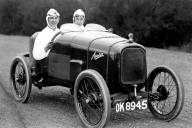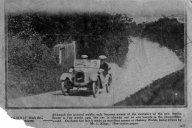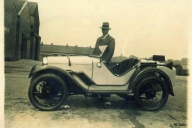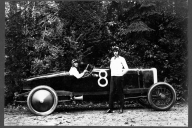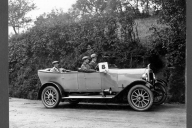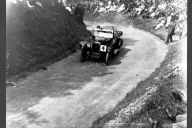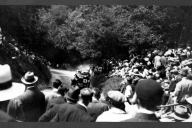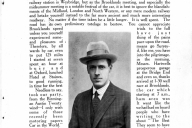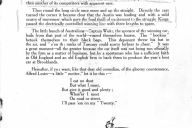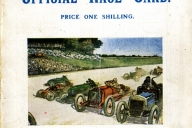Austin Development Engineer and Works Racing Driver.
Thomas Lewis King was born in June 1888 at 58 Church Hill in the village of Bishop Tachbrook, Warwickshire. His father is listed at various times as both a milkman and domestic servant. Lou was one of seven children and was described in the 1901 census, at the age of twelve, as a newspaper agent.
Whilst at school his teacher decided that no person should have a name emulating that of the King, ruling that Lou’s name be changed to Kings. This remained his surname for the rest of his life.
In his early teens Lou ran away from home, allegedly to avoid his abusive father, taking him to Redditch twenty or so miles away to become a ‘tester’ with the Lee Enfield Company. Whether he worked on motorcycles or the Enfield car is not known. His work may have attracted the attention of Herbert Austin as in 1908 Lou moved to the Austin Motor Company. He was to remain here for the rest of his working life. It is believed that early on Lou was seconded to the Zenith Carburettor Company, leading him to become head of carburation, test and development at Austin’s.
Lou was very much involved in the development of the 50hp armoured car during WW1. Working closely with the Russian Imperial Army, who had been customers of Austin since 1906, he welcomed their generals to Longbridge for trials, as well as travelling to Russia and Mesopotamia.
Having the luxury of driving and testing cars, Lou was recognised as having potential as a racing driver and in 1919 became a successful driver of the Austin 20 Sports. In 1920 he won the 20 hp class at Shelsley Walsh hill climb, repeating this success in 1922 and 1924. 1921 saw him beat Malcolm Campbell’s Talbot into second place at Brooklands, averaging 75 mph. A year later again driving the 20 hp Austin he won the 100-Mile Handicap and Senior Sprint at Brooklands with an average speed of 83 mph. Over the years Lou had many victories on English, Irish and Continental tracks.
When Austin commenced design of the Seven Lou worked closely with Stanley Edge to develop the model. Secrecy was paramount during the building of the first three Sevens and it is understood that each evening Lou would gather up the blueprints, place them into a specially made tube and safely store them overnight at his home. Some of these original blueprints remained in the Kings’ family but unfortunately were lost in a fire. Once the cars were built Lou became only the second person, after Sir Herbert, to drive the first Seven. Within a week or so of the announcement of the Seven to the general public, Lou competed in the model at Shelsley Walsh – the car’s very first competitive outing. Lou established himself as part of the Seven racing team, gaining early successes until crashing and injuring himself in the now famous Boulogne race. By that time Lou was married and, under pressure from his wife, ceased racing in 1926. He continued however to work over the subsequent years with Arthur Waite and Harold Cutler, fellow drivers, helping to steer the model towards more racing success.
Lou eventually became Superintendent of the Finished Test Department at Longbridge, a position he held until 1949 when his wife became terminally ill. During his time at Austin’s Lou played a small part in the development of the Whittle jet engine by sourcing and developing two Seven engines which were used in the engine’s test rig.
Lou was very well regarded by the management of the Company, including Leonard Lord, but sadly died suddenly at the age of 62.
Chris Garner.
(My thanks to Mr Ian Hughes, one of Kings’ grandsons, for his help with this biography)
![]()
Gallery Information:
Each image has a caption, if you can contribute further knowledge to the relevant images please add a comment (subject to moderation) by clicking the speech bubble icon to write your comment.



